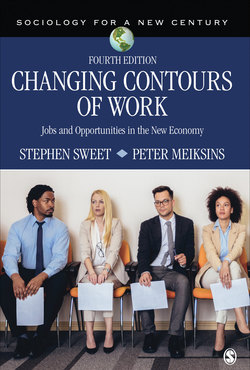Читать книгу Changing Contours of Work - Stephen Sweet - Страница 27
На сайте Литреса книга снята с продажи.
A Postindustrial Society?
ОглавлениеOne of the earliest forecasts of an emergent new economy came from sociologist Daniel Bell (1973), who argued in the early 1970s that America was entering a “postindustrial” era, in which the manufacturing-centered economy of the past was being replaced by an economy directed toward the provision of services. Bell was among the first to note something that subsequently became obvious to most Americans, particularly those located in the so-called rust belt of the industrial Midwest—employment opportunities had shifted away from manufacturing to other sectors of the economy.
Exhibit 2.1 shows that in 1940 the number of employees working in the manufacturing sector in America was more than double that in any other sector of the economy, accounting for over one-third of all employment. Until 1989, the manufacturing sector remained the largest employment sector. But as the population of the United States grew during the latter part of the twentieth century, manufacturing employment did not. Today, instead of employing one in three workers, as it did in the mid-twentieth century, manufacturing enterprises employ fewer than one in ten workers.
There are various explanations for this trend. Some argue that nearly all low-skill, low-wage manufacturing work is being funneled to developing economies, while the advanced economy of the United States focuses on knowledge work and services (Fröbel, Heinrichs, and Kreye 1982). However, it is also possible to argue that this simply reflects something “old”—the continued effort of employers to find the least expensive ways to produce goods (Cowie 2001). From this point of view, manufacturing remains central to the economy; however, it now takes place on a global scale, rather than on a national one. Yet another interpretation emphasizes that the United States is unusual—the decline of manufacturing employment is more pronounced here than elsewhere. Rather than reflecting a long-term, general trend away from manufacturing, the U.S. pattern may reflect a choice by American employers to seek low-wage sites for manufacturing rather than invest more heavily in improving techniques at home (Appelbaum and Batt 1992). It may also reflect domestic economic policy choices favoring a strong U.S. dollar and the U.S. government’s tolerance of policies in countries such as China, which keep their currencies artificially low. Such policies hurt U.S. manufacturing exports and make imported goods cheaper, resulting in stagnant or declining manufacturing employment in the United States (Scott 2015). All of these processes have played a role in shaping opportunity in the new economy.
Exhibit 2.1 Trends in Employment in Twelve Major Sectors: United States, 1940–2017
Source: Bureau of Labor Statistics.
The number of manufacturing jobs has declined in the United States and other economically advanced countries, but should we conclude that we are truly postindustrial? In the new economy, manufacturing enterprises continue to employ more than 12 million American workers. This may be an underestimate, as many industrial employers make increasing use of temporary workers, many of whom are not counted as industrial workers in government statistics. Although manufacturing employs a smaller percentage of Americans than it once did, it remains a major force in the economy and creates demand for the products and services generated in other parts of the economy (Hatton 2011, Scott 2015). It is not at all clear that manufacturing employment is in an inevitable long-term decline to the point where it will disappear entirely. Rather, it remains an important but less dominant part of what is now a more diversified economy. It is also important to recognize that while the United States might view trends as “losses,” other countries, particularly those in the global south, view the movement of manufacturing jobs as “gains,” resulting in substantial economic improvements in those societies (Pandian 2017).
The fact that manufacturing opportunities have stagnated and declined in the United States does not mean that manufacturing jobs will entirely disappear. Nor does it mean that the ways of working that developed in the old economy are on a path to disappearing as a result. The practices of the old industrial economy are woven into the design of many jobs central to the new economy.
